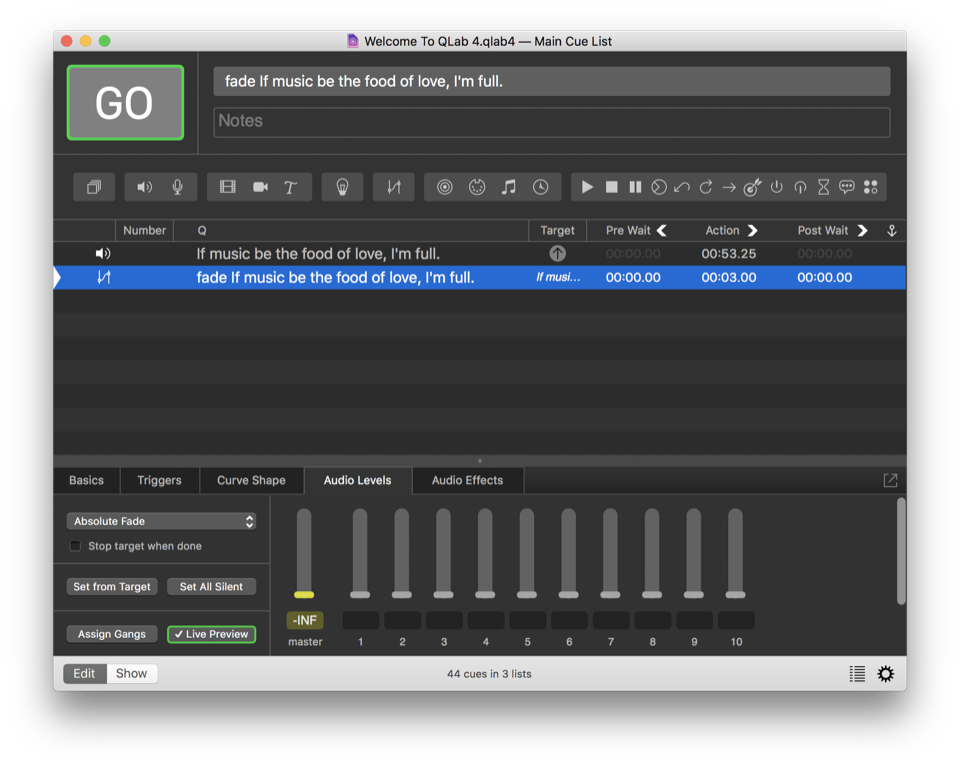

The Audio and Fade cues, which again make the whole cue list more readable. Typed, without overwriting the descriptions that are automatically created for It creates a space in the Group cue description for a title for the cue to be.Scan the entire cue list to ensure that none exist where they shouldn’t. Number of auto-continues or auto-follows that you’re using makes it easier to ( C is dangerously positioned directly above the space bar). It’s easier to spot auto-continues or auto-follows that have been accidentallyĬreated, either by accidental clicking in the continue column, or if using theĭefault keymap accidentally catching the hotkey for creating a continue.It’s easier to see the structure of the cue list.Of these two methods, the Group cue method (method 2) has many advantages. Simultaneously” and it can be found in Workspace Settings → Group.) In QLab 3, the setting is called “Start all children You can set this in QLab 4 by visiting Workspace Settings → Cue Templates If you are going to create fades using this method, it is helpful to set theĭefault mode of Group cues to “Timeline - start all children simultaneously”. You can type a description of the cue in the Q column of the group cue.The two cues will be placed inside the newly created Group cue.Click on the Group cue icon in the toolbar, or use keyboard shortcut.Select the Audio cue and the Fade cue, by clicking on the Audio cue and then.This is indicated by a triple-headed arrow: In the cue list, click in the rightmost column of the Audio cue once, to enableĪuto-continue. Immediately after the Audio cue is triggered. There are then two main methods that can be used to make the Fade cue start


Now, fading in an Audio cue requires starting both the Audio cue and the FadeĬue. Ensure that Live Fade Preview is on (found under the Tools menu or in theĪudio Levels tab of the Fade cue’s inspector) and adjust the master level of.Start the Audio cue by pressing the space bar or clicking on the GO button.Set the master level of the original Audio cue to -INF.Toolbar or using the keyboard shortcut ⌘7 Create a fade cue underneath this cue by clicking the fade cue icon in the.Set the duration of the Fade cue in the action column or the Curve Shape tab.Stop target when done (unless you are going to fade the Audio cue back up Set the master level of the Fade cue to -INF and click the checkbox labeled.Manually set the target of the Fade cue by dragging the Audio cue on top of If you are using an earlier version of QLab, If you are using QLab 4.4 or later, the Fade cue will automatically target.Create a Fade cue underneath this cue by clicking the Fade cue icon in the.If you are going to want the cue to fade out at some point, you might as wellĬreate that fade now and then either drag or cut-and-paste it into the required Starting point for both methods is the same: Drag a stereo audio file into the All level setting will be done with the master fader.įirst, let’s take a quick look at the two main programming styles for fades. In these examples, we will use simple stereo cues assigned to cue outputs 1 andĢ at 0dB. This is a very short chapter that provides anĪppleScript-based method for quickly creating fades in and out for Audio cues. Every Audio cue you start is likely to require a fade out at some point,Īnd often a fade in. One of the most repetitive tasks when programming a show in QLab is creatingįades.


 0 kommentar(er)
0 kommentar(er)
